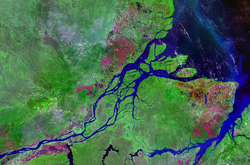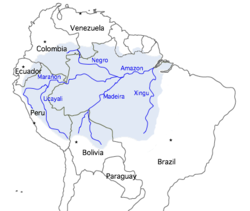Amazon River


The Amazon River (also called Rio Amazonas in Portuguese and Spanish[1]) is the largest river in the world by the amount or volume of water it carries. It flows through the tropical forests of South America, mainly in Brazil. Its headwaters are in the Andes Mountains in Peru, on the western edge of South America and flows eastward into the Atlantic Ocean near the equator.
The Amazon River moves more water than the next eight largest rivers of the world combined and has the largest drainage basin in the world. It accounts for about one fifth of the world's total river flow. During the wet season, parts of the Amazon exceed 120 miles (190 km) in width. Because of its size, it is sometimes called The Sea, but it is not the world's longest river system. The world's longest river is the Nile River, with the Amazon being second-longest.
Overview[change | change source]
All the main tributaries to the Amazon River have their own names. They start in the mountains (Andes) as clear water with high oxygen content, and connect with the other rivers as they all flow towards the mouth of the Amazon.
The water of the Amazon ends up full of mud. This is especially true of its Rio Negro tributary). In the nutritious mud live a huge number of insects, small crustacea, parasites. On these small fry live predators, birds, fish and life generally. The mud is what causes this huge array of life. The mud has nutrients, and on this the flies and fish all the other animals depend.
Size and path[change | change source]
It is one of the longest rivers in the world. There have been different studies that have tried to measure its exact length. As the studies have come up with different numbers, it is therefore difficult to give an exact number. The length also changes in the rainy season. Several studies from Brazil, Spain and Chile say it is the longest river in the world, longer than the Nile. The Nile has a length of 6,571 kilometres (4,083 mi). The Amazon may have a length of 6,937 km (4,310 mi).[2][3][4] The Spanish daily newspaper El País gives its length at 6,850 km (4,260 mi).[5] In 2007, scientists from Peru and Brazil calculated a length of 6,800 km (4,200 mi).[6]
A study done in 1969 says that the Amazon has a length of 6,448 km (4,007 mi). This was measured from a part of the River Apurimac. Until the 1970s, it was thought that the Marañón River was the source of the Amazon. In 2001, an expedition found that Nevado Mismi was in fact the source of the Amazon.[7] Another document of the Geographic society of Lima gives the length of the Amazon at over 7,000 km (4,300 mi).[8]
The source of the Amazon is in the Andes Mountains of western South America. It flows east from there to the Atlantic Ocean. Most of the huge river and its many tributaries are in the country of Brazil. There are many places on the Amazon where a person on one side of the river cannot see the other side. The Brazilians call the Amazon the "River Sea." The Amazon is navigable from the ocean to Peru. Ocean ships can travel on the Amazon all the way across Brazil, and most of South America, to the city of Iquitos in Peru.
One characteristic of the Amazon river is the Brazo Casiquiare, a water connection to the Orinoco river into Venezuela, that connects the two basins.
Estuary[change | change source]

The estuary of the Amazon is about 330 km (205 mi) wide. The width of the mouth of the river is usually measured from Cabo do Norte to Punto Patijoca. Generally, the outlet of the Para River is included. It is 60 km (37 mi) wide, and forms the estuary of the Tocantins. The estuary also includes the island of Marajó, which lies in the mouth of the Amazon. This means that the Amazon is wider at its mouth than the entire length of the Thames river in England.
Along the coastline, near Cabo do Norte, there are many islands partially covered with water. There are also sandbanks. The tides of the Atlantic generate a wave that reaches into the Amazon river. This wave goes along the coast for about 420 kilometres (261 miles). The phenomenon of this wave generated by the tides is called a tidal bore. Locally it is known as pororoca. The pororoca occurs where the water is less than 7 m (23 ft) deep. It starts with a loud noise, and advances at a speed of 15–25 km/h (9–16 mph). The bore is the reason the Amazon does not have a delta. The ocean rapidly carries away the large amount of silt brought by the Amazon. This makes it impossible for a delta to grow past the shoreline. It also has a very large tide, that can reach 6 metres (20 feet). The place has become popular for river surfing.[9]
Uses[change | change source]
The Amazon River has many uses:
- Hydroelectric power is got from the river. There are dams all along the Amazon river which build up pressure.
- People travel to it.
- The indigenous people carry food down it and canoe down it to trade.
- Some of it is fresh water, so animals can drink from it.
- People grow crops on its banks.
"Uses" suggests that the wonders of the Earth are there for our taking. They are not. It is up to us what we do, and the Amazon has already been greatly damaged by greed and corruption. Logging its trees and changing the ecosystem to farmland is already far advanced.
Bridges[change | change source]
There are no bridges across the entire width of the river.[10] This is not because the river would be too wide to bridge; for most of its length, engineers could build a bridge across the river easily. For most of its course, the river flows through the Amazon Rainforest, where there are very few roads and cities. Most of the time, the crossing can be done by a ferry, so there is no need to build a bridge. The Manaus Iranduba Bridge linking the cities of Manaus and Iranduba spans the Rio Negro (a tributary of the Amazon).
The river is the main route of traffic in the region. Most cities are on the banks of the river. The biggest city on the river is Manaus, which is also the capital of the Brazilian State of Amazonas. Many native people live in the Amazon, such as the Urarina[11] who live in Peru.
Trade route[change | change source]
Big ocean boats can get up the river until Manaus, which is almost 1500 kilometers (900 miles) from its mouth. Smaller ocean ships of 3,000 tons [12] and 7.9 m (26 ft) draft[13] can reach as far as Iquitos in Peru, 3,700 km (2,300 miles) from the sea. Smaller riverboats can reach 780 km (486 mi) higher as far as Actual Point. Beyond that, small boats frequently go up to the Pogo Ode Escherichia's, just above Actual Point.
References[change | change source]
- ↑ "Amazon River". Encyclopedia Britannica.
- ↑ Caderno Ciência, pág. 1, Folha de São Paulo, 3 July, 2008.
- ↑ Arce, Jean (1 May 2007). "Amazonas supera o Nilo como rio mais longo, dizem cientistas". Uol (in Portuguese). Retrieved 2008-05-11.
- ↑ Almeida, Maciel (16 May 2007). "Amazonas é o rio mais extenso". O POVO (in Portuguese). Archived from the original on 2007-09-27. Retrieved 2008-11-05.
O rio Amazonas é o mais extenso do mundo e nasce ao sul do Peru e não ao norte, como dizem os atlas e livros escolares. Técnicos do IBGE concluíram que a extensão do rio Amazonas pode ultrapassar os 6,850 km, superando o rio Nilo
- ↑ "El río más largo del mundo". El Pais. June 16, 2007.
- ↑ "Amazon Longer than Nile River, Scientists Say". National Geographic. 2007.
- ↑ "Explorers Pinpoint Source of the Amazon". National Geographic News. December 21, 2000.
- ↑ "The Amazon River without secrets" (PDF). 2008. Archived from the original (PDF) on 2011-09-29. Retrieved 2009-07-26.
- ↑ "Pororoca: surfing the Amazon". Retrieved 2008-08-01.
- ↑ "Amazon (river)" (2007 ed.). Microsoft Encarta Online Encyclopedia. Archived from the original on 2008-03-06. Retrieved 2007-08-12.
- ↑ UPF. "Urarina Society, Cosmology, and History in Peruvian Amazonia". University Press of Florida: Urarina Society, Cosmology, and History in Peruvian Amazonia.
- ↑ "Amazon - MSN Encarta". Archived from the original on 2009-10-31. Retrieved 2006-01-31.
- ↑ "Peru port information".[permanent dead link]
Other websites[change | change source]
- Amazon River and Amazon Rainforest virtual tour Archived 2009-04-18 at the Wayback Machine
- Information on the Amazon from Extreme Science Archived 2010-02-06 at the Wayback Machine
- Map of South America Archived 2005-02-05 at the Wayback Machine
- Pictures of the Amazon River
- Amazon River and rain forest photos and information
- An Amazon River web site
- Information and a map of the Amazon's watershed Archived 2004-12-14 at the Wayback Machine
- river tours[permanent dead link]
